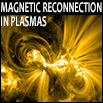Speaker
Dr
Jonathan Eastwood
(Imperial College London)
Description
Magnetic reconnection is one of the most important processes at work
in space
plasma environments, controlling energy storage, transport and
release. In
particular, it is crucial to the physics of the solar wind - magnetosphere
interaction
because it can explosively release stored energy, transforming it into
different forms
in the reconnection outflow. Magnetotail reconnection can be divided
into three
interacting regions: the diffusion region in the vicinity of the X-line, the
exhaust,
and the dipolarization front, where the exhaust leading edge interacts
with the pre-
existing plasma. Here we review and discuss recent work examining
aspects of
energy transfer and partition in different parts of the magnetotail
reconnection
process.
The required change in field topology takes place in the electron
diffusion region,
enveloped by the larger ion diffusion region. Analysis of Cluster data
has revealed
that the partition of energy coming out of the diffusion region into the
exhaust
appears to be, on average, dominated by ion enthalpy flux, although
there is also a
large and significant Poynting flux which in localized regions may in fact
dominate.
Electron heating also occurs in the ion diffusion region; this heating is
anisotropic
and limited by various instabilities which may play an important role in
mediating
reconnection physics near the X-line.
The dipolarization front (DF) is formed at the leading edge of the
exhaust by its
interaction with the pre-existing plasma sheet. The results of a new
study using
THEMIS are presented showing that the exhaust does not simply push
pre-existing
material out of the way, but that via kinetic effects, some pre-existing
plasma sheet
plasma is entrained and accelerated into the exhaust. This interaction
in fact occurs
over a macroscopic region, rather than simply being limited to the thin
DF interface.
A more general consequence is the conclusion that reconnection
exhausts are not
simply fed by plasma inflow across the separatrices, but are also fed by
plasma from
the region into which the jet is propagating; the implications of this
finding are
discussed.
Primary author
Dr
Jonathan Eastwood
(Imperial College London)

